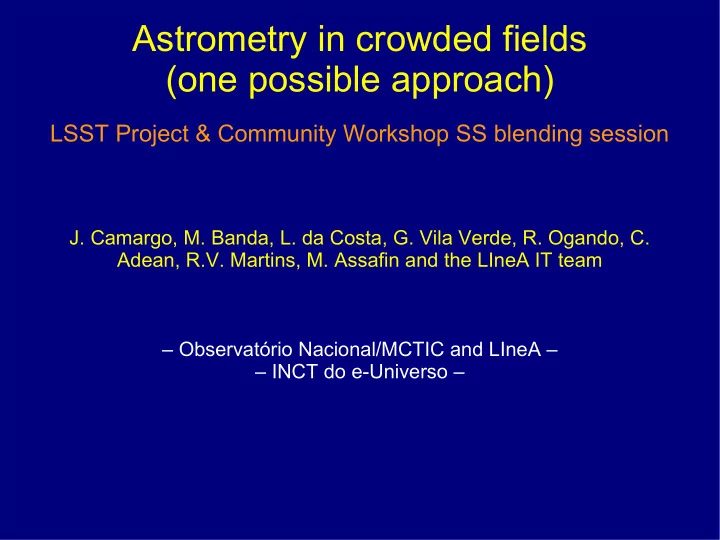

Astrometry in crowded fields (one possible approach) LSST Project & Community Workshop SS blending session J. Camargo, M. Banda, L. da Costa, G. Vila Verde, R. Ogando, C. Adean, R.V. Martins, M. Assafin and the LIneA IT team – Observatório Nacional/MCTIC and LIneA – – INCT do e-Universo –
Astrometry in crowded fields (one possible approach) Motivation ● Galactic plane in the background ● Larger number of occultation events but astrometry (and not only it) is obviously difficult. Astrometric codes plus Difference Image Analysis is one possible solution
Test case: (10199) Chariklo Moving object SOAR/SOI on 2015-07-20T01:37:17 DIA2 – Many thanks to Wojtek Pych http://users.camk.edu.pl/pych/DIAPL/
Steps ● Astrometry on the dense fields (PRAIA, Assafin et al. 2011 - Gaia FUN-SSO workshop proceedings ). ● Template image → create it from images that are sufficiently separated in time. ● Astrometry on the subtracted images. ● Replace the (x,y) coordinates of the moving object in the crowded image by that from the respective subtracted image.
Results ● ● Before: Target could not even be disentangled from field star close by. ● ● After: Δαcosδ = -3 mas Δδ = 12 mas (dispersion below 10 mas) Offsets with respect to an accurate ephemeris
The ephemeris Mas-level accuracy!
Comments ● Definitely, a way to deal with crowded fields: lower rejection of images, higher precision for target's position. ● Relies, among others, on the necessarily good alignment between images. ● Deblending reference stars – ongoing. ● Template images could perhaps be taken when the moving body is no longer (or is not still) in the desired field. ● Possible to build a pipeline.
Recommend
More recommend